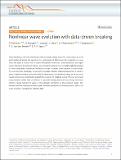| dc.contributor.author | Eeltink, D. | |
| dc.contributor.author | Branger, H. | |
| dc.contributor.author | Luneau, C. | |
| dc.contributor.author | He, Y. | |
| dc.contributor.author | Chabchoub, A. | |
| dc.contributor.author | Kasparian, J. | |
| dc.contributor.author | van den Bremer, T. S. | |
| dc.contributor.author | Sapsis, T. P. | |
| dc.date.accessioned | 2024-04-18T21:04:28Z | |
| dc.date.available | 2024-04-18T21:04:28Z | |
| dc.date.issued | 2022-04-29 | |
| dc.identifier.issn | 2041-1723 | |
| dc.identifier.uri | https://hdl.handle.net/1721.1/154221 | |
| dc.description.abstract | Wave breaking is the main mechanism that dissipates energy input into ocean waves by wind and transferred across the spectrum by nonlinearity. It determines the properties of a sea state and plays a crucial role in ocean-atmosphere interaction, ocean pollution, and rogue waves. Owing to its turbulent nature, wave breaking remains too computationally demanding to solve using direct numerical simulations except in simple, short-duration circumstances. To overcome this challenge, we present a blended machine learning framework in which a physics-based nonlinear evolution model for deep-water, non-breaking waves and a recurrent neural network are combined to predict the evolution of breaking waves. We use wave tank measurements rather than simulations to provide training data and use a long short-term memory neural network to apply a finite-domain correction to the evolution model. Our blended machine learning framework gives excellent predictions of breaking and its effects on wave evolution, including for external data. | en_US |
| dc.language.iso | en | |
| dc.publisher | Springer Science and Business Media LLC | en_US |
| dc.relation.isversionof | 10.1038/s41467-022-30025-z | en_US |
| dc.rights | Creative Commons Attribution | en_US |
| dc.rights.uri | https://creativecommons.org/licenses/by/4.0/ | en_US |
| dc.source | Springer Science and Business Media LLC | en_US |
| dc.subject | General Physics and Astronomy | en_US |
| dc.subject | General Biochemistry, Genetics and Molecular Biology | en_US |
| dc.subject | General Chemistry | en_US |
| dc.subject | Multidisciplinary | en_US |
| dc.title | Nonlinear wave evolution with data-driven breaking | en_US |
| dc.type | Article | en_US |
| dc.identifier.citation | Eeltink, D., Branger, H., Luneau, C. et al. Nonlinear wave evolution with data-driven breaking. Nat Commun 13, 2343 (2022). | en_US |
| dc.contributor.department | Massachusetts Institute of Technology. Department of Mechanical Engineering | |
| dc.relation.journal | Nature Communications | en_US |
| dc.eprint.version | Final published version | en_US |
| dc.type.uri | http://purl.org/eprint/type/JournalArticle | en_US |
| eprint.status | http://purl.org/eprint/status/PeerReviewed | en_US |
| dc.date.updated | 2024-04-18T21:00:39Z | |
| dspace.orderedauthors | Eeltink, D; Branger, H; Luneau, C; He, Y; Chabchoub, A; Kasparian, J; van den Bremer, TS; Sapsis, TP | en_US |
| dspace.date.submission | 2024-04-18T21:00:41Z | |
| mit.journal.volume | 13 | en_US |
| mit.journal.issue | 1 | en_US |
| mit.license | PUBLISHER_CC | |
| mit.metadata.status | Authority Work and Publication Information Needed | en_US |
